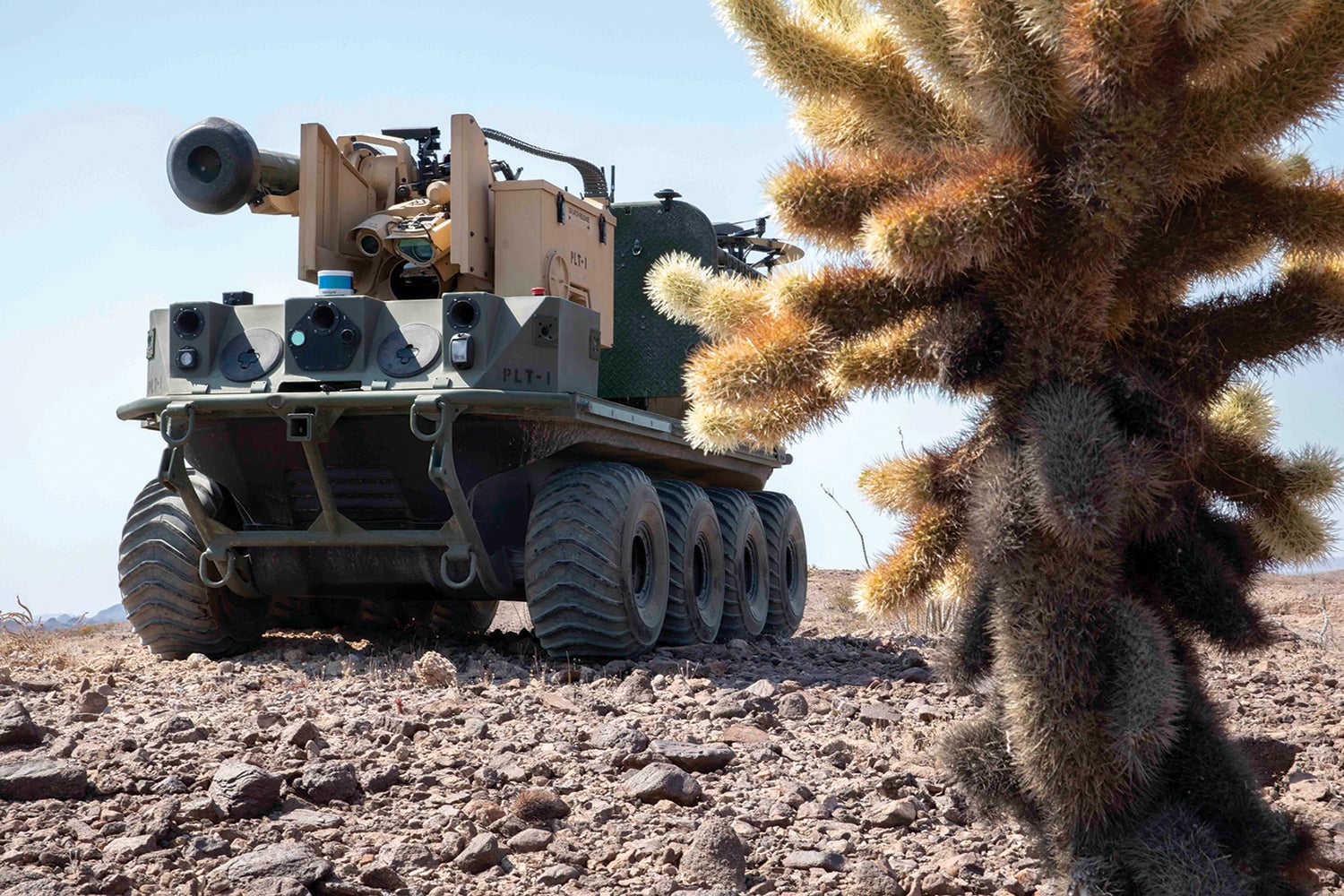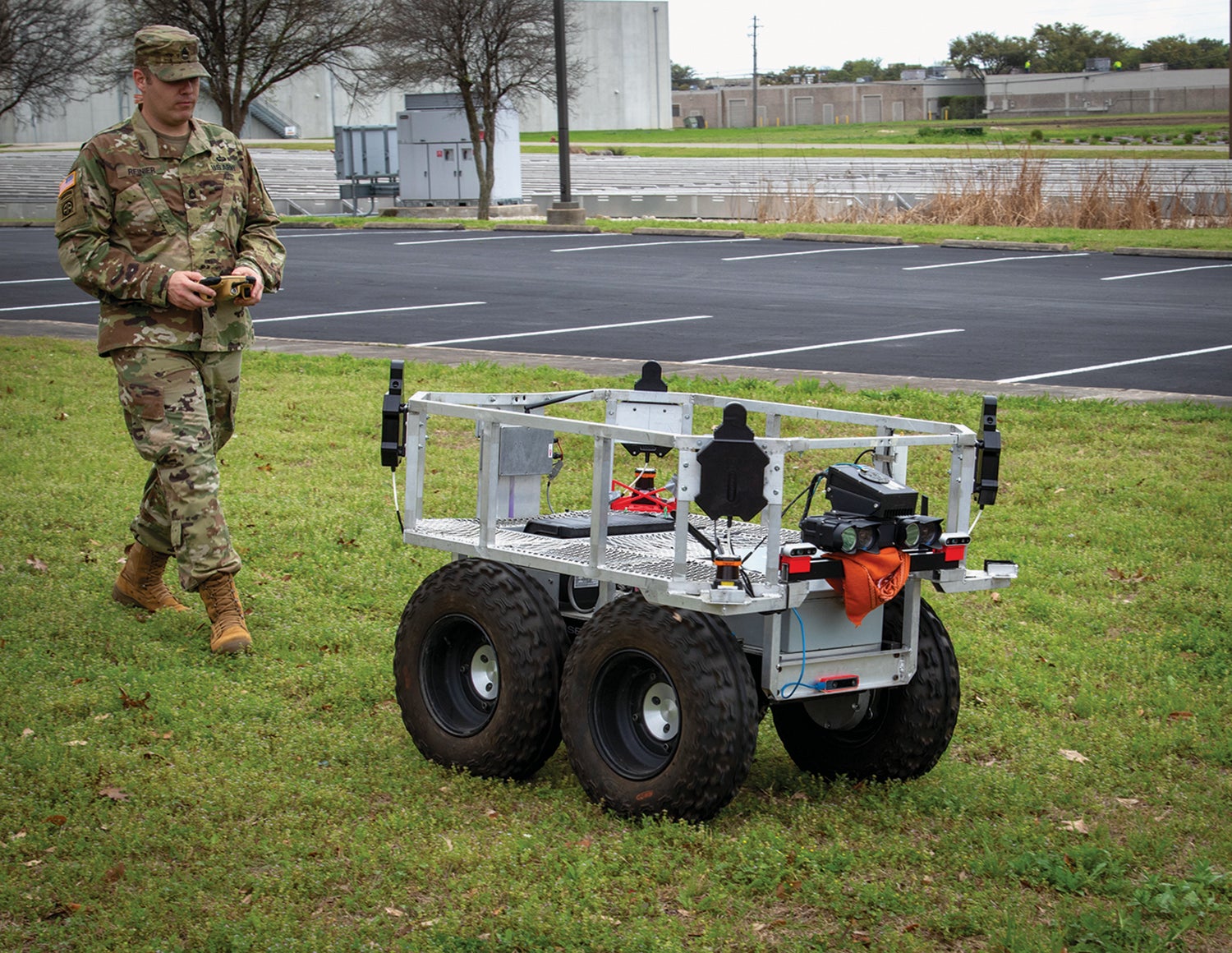Ensuring continuous soldier readiness is paramount to success on any battlefield. As the Army prepares for the complexities of multidomain operations, why would it expect anything less from its robotic teammates?
For all the wonders and promise that robots hold, many are still quite clumsy, noisy and needy. A loud, hot robot operating in a laboratory environment is one thing. Noise and thermal signatures from such a robot on the battlefield could put soldiers and the entire mission at risk. Deep mud and sudden changes in ground conditions can stop some robots in their tracks.
Then there is the matter of operating in environments where an uninterrupted supply of electricity is not always a certainty. Robotic exoskeletons, unmanned ground vehicles (UGVs) and unmanned aerial vehicles (UAVs) share a ravenous appetite for some of the most precious resources on the battlefield: power and energy. With its batteries drained and no charging station in sight, a robotic asset can go from a mission-critical asset to a mission liability in the blink of an electric eye. A dead robot could degrade combat power, give away a soldier or squad position, or unintentionally deliver critical Army technology into the hands of adversaries.
Complex Battlefields
The U.S. Army Robotic and Autonomous Systems Strategy, issued in March 2017 by the U.S. Army Training and Doctrine Command, is evolving to better exploit these assets on far more complex battlefields, as described by the Multi-Domain Operations concept. Rapid, adaptive convergence of physical and cyber assets across ground, air, sea, space and cyberspace domains is a key feature of multidomain battle. The true multidomain competitive advantage, however, will reside in the speed with which these assets can be deployed to exploit battlefield complexity and achieve mission objectives.
If robots lose power, sink instead of scurry across sand, or are unable to traverse irregular and discontinuous terrain (rivers, gullies, canyons), they will fail to deliver the operational tempo and support that soldiers will increasingly rely upon in the future.
New and game-changing approaches to robot design, infrastructure and robot/robot teaming will give Army robotic and autonomous systems assets the resilience they need to keep up with their soldier teammates.
Logistical Support
Tesla Inc. electric vehicles went the extra mile and developed nationally distributed infrastructure for recharging. The result? A leap-ahead capability to give customers the freedom and confidence to travel distances not possible before for many electric vehicles. Self-driving electric vehicles are not unlike robotic systems in terms of logistical support.
The Army is exploring more deployable concepts to create “on demand” infrastructure so its robotic and autonomous systems assets remain capable and endure longer. This includes new and transformative ways to create self-sustaining power sources, infrastructure and robot behaviors that keep Army robots mobile and persistently mission-capable.
Water Into Fuel
The U.S. Army Combat Capabilities Development Command (CCDC) Army Research Laboratory invented a “nanogalvanic” aluminum alloy that can rapidly and safely transform water into electricity with no toxic byproducts. When exposed to water, the alloy reacts to produce hydrogen, which then can be converted into electricity by means of a fuel cell. In essence, the alloy can transform water found in the mission environment into fuel for robots.
Unlike conventional batteries, the alloy can generate power on demand and recharge spent batteries. The alloy can be additively printed into complex, load-bearing structural components, such as a robot fuselage or maneuvering flipper. This creates the possibility for a new approach to the design and operation of robotic and autonomous systems—including systems that can essentially “eat” themselves as a fuel of last resort.
While self-cannibalizing robots may not be necessary or practical in many commercial applications, they could make all the difference in remote, logistically denied Army mission environments when robotic and autonomous systems assets need to survive long enough to achieve mission objectives. Computer models were used to explore how a robot flipper made from the nanogalvanic aluminum could be partially “cannibalized” to generate hydrogen and electricity. The water/alloy reaction eventually stops, leaving the minimal amount of flipper structural integrity needed for robot movement and maneuver.
In addition to extending endurance, this concept could keep the robot’s sensors, transmitter and tracking device powered up long enough to be located and retrieved. Alternatively, the spent robot could be sacrificed as a source of fuel to keep other nearby unmanned aerial and ground vehicles operating longer.
Persistently Mission-Ready
The nanogalvanic aluminum alloy also could offer a new way to keep UAV assets persistently mission-ready. It takes a tremendous amount of energy for rotor-based UAVs to defy gravity, which can rapidly drain batteries and limit useful flight time. Many UAV batteries can take upwards of one to three hours to fully recharge, yet offer only 15 to 45 minutes of usable flight time.
Worse yet, some UAVs can spend a significant amount of time returning to and from distant launch points, reducing the actual time spent conducting their mission. One concept being explored between the CCDC Soldier Center and the Army Research Laboratory, and Asylon Inc., is the possibility of airdropping a portable battery charging and replacement station close to the area where the UAV is operating.
Nicknamed “Birdbath,” the concept uses a source of water in the mission environment (e.g., snow, streams, ponds) and Army Research Laboratory’s nanogalvanic alloy to generate electricity to recharge depleted batteries—but only after they are removed from the UAV. The Army is exploring how this in-theater source of alloy-based electricity could interface with Asylon’s patented DroneHome technology.
Asylon, a small Philadelphia-based company founded by three graduates of the Massachusetts Institute of Technology, invented DroneHome as a means to automate the removal and replacement of UAV batteries, allowing the vehicles to routinely land and quickly swap out depleted batteries. The goal is not to extend the life of a UAV battery, but rather, rapidly replace spent batteries so the vehicle can return to its mission sooner.
The Birdbath concept also can work in other unique mission environments. For example, a simulant of sewage often found in subterranean environments has been successfully converted into electricity using Army Research Laboratory’s nanogalvanic alloy. The conversion of sewage into a mission asset could keep both UAVs and their onboard sensors powered up longer in logistically challenging subterranean environments.
The University of Massachusetts Lowell is exploring Asylon’s UAV as a platform to deploy its novel methods for standoff detection of gases and toxic substances. This could give the Soldier Center and Army Research Laboratory the ability to demonstrate transformative concepts to persistently operate in dangerous subterranean and other mission environments.
Reshaping Terrain
The Army’s mission statement emphasizes “ready, prompt and sustained land dominance,” implying that the service must have assured freedom of movement and maneuver on and near the ground. Ground-based robots must be as nimble as soldiers over terrain that may be wet, dry or obstructed.
NASA faces a similar problem with its rovers. Getting stuck on a planet 49 million miles away from Earth can be a serious mission setback. Keeping robots from getting stuck is what interested the Army Research Laboratory’s Army Research Office and NASA’s Johnson Space Center to sponsor a team of researchers led by professor Daniel Goldman at the Georgia Institute of Technology to understand and apply new insights of how robots and terrain interact.
As part of this team, physics doctoral candidate Andras Karsai designed a robot “rover” that can reshape local terrain, enabling quicker mobility over otherwise perilous soil conditions. For example, certain types of deep, granular sand pose a difficulty for tracked, wheeled and legged robots.
This rover, however, is endowed with an unusually high degree of flexibility and control to “self-organize” the sand. Rather than digging farther into a potential sand trap, the rover’s front wheels can actively organize the sand so the rear wheels can better propel the rover forward.
Unlike conventional vehicles, this type of research suggests that a robot needn’t accept the difficult terrain it might encounter; it can modify the terrain to meet its own needs for sustaining rapid locomotion.
Free-Range Robots
As part of its mission to operationalize science for transformational overmatch, the Army Research Laboratory quickly realized the limitations of developing robotic capabilities in the isolation of a laboratory environment. Earlier contact with soldiers and other CCDC centers, universities and industry could help accelerate development and transition of new robot concepts and discoveries.
A former Superfund site at Aberdeen Proving Ground, Maryland, has been safely repurposed to become a testbed for this type of exploration and technology incubation. The initial 12-acre facility is known as the Robotics Research Collaboration Campus (R2C2). R2C2 allows testing of robots fresh off the lab bench. Equally important, it enables exploring revolutionary ways robots can use supportive infrastructure to be more effective on the battlefield.
One such R2C2 project is emerging from collaboration between Army Research Laboratory Northeast and the Massachusetts Institute of Technology’s Center for Bits and Atoms. Center Director professor Neil Gershenfeld and doctoral student Benjamin Jenett ask: How do we achieve true “4D-mobility” to enable leap-ahead approaches to persistent movement and maneuver?
One promising answer is to create structural robots, dubbed “strobots,” that can be formed and re-formed into useful, load-bearing structures. Imagine instead of a bridge composed of fixed structural elements (trusses, beams, cables, etc.), strobots could intelligently “swarm” to form a temporary bridge. After the bridge enables transport of soldiers, robotic and autonomous systems assets, equipment, etc., the strobots could disassemble for compact storage and transport, greatly reducing the logistics burden.
While Army and university researchers bring such transformative concepts to life, it is feedback from soldier touchpoint events that will ensure success on the battlefield. Using their experience and knowledge, soldiers can quickly confirm or reject features and capabilities before they evolve into impractical or incomplete solutions.
It is precisely this kind of early researcher/soldier interaction the Army and facilities like R2C2 seek to unite so future robots will continue to evolve as worthy soldier teammates in multidomain operations and beyond.






